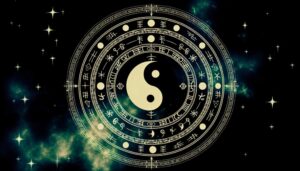Understanding the Meaning of the Aum Symbol and Its Spiritual Significance
The Aum symbol, rooted in ancient Hindu scriptures such as the Vedas and Upanishads, represents the ultimate reality and cosmic essence. Its components—three curves, a dot, and a semicircle—symbolize different states of consciousness: waking, dream, and deep sleep.
In Hinduism, Aum signifies the essence of Brahman, the unifying principle of existence. Buddhism reveres it for illustrating interconnectedness and impermanence.
Contemporary use in mindfulness and meditation underscores its enduring cultural relevance. The symbol's multifaceted meaning and its role in spiritual practices offer a rich tapestry of insights into human consciousness and the universe's interconnected fabric.
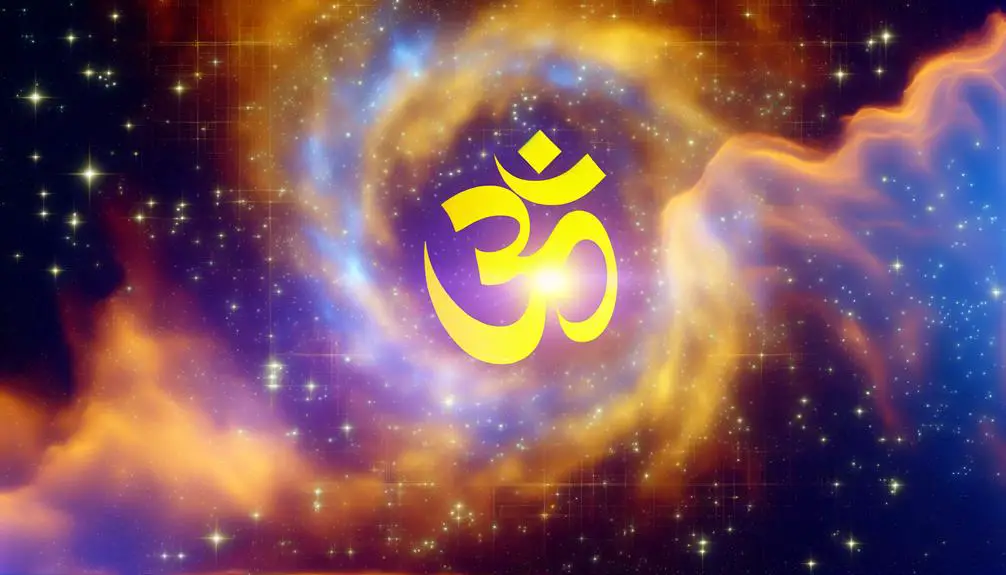
Key Takeaways
- Represents the ultimate reality and interconnectedness of all existence in Hinduism and Buddhism.
- Symbolizes the union of the physical and spiritual realms, aiding in self-realization and inner peace.
- Embodies the cosmic essence, encompassing the waking, dream, and deep sleep states of consciousness.
- Revered as a primordial vibration, aligning individual consciousness with spiritual truths.
- Widely used in contemporary mindfulness and meditation practices for vibrational harmony.
Historical Origins
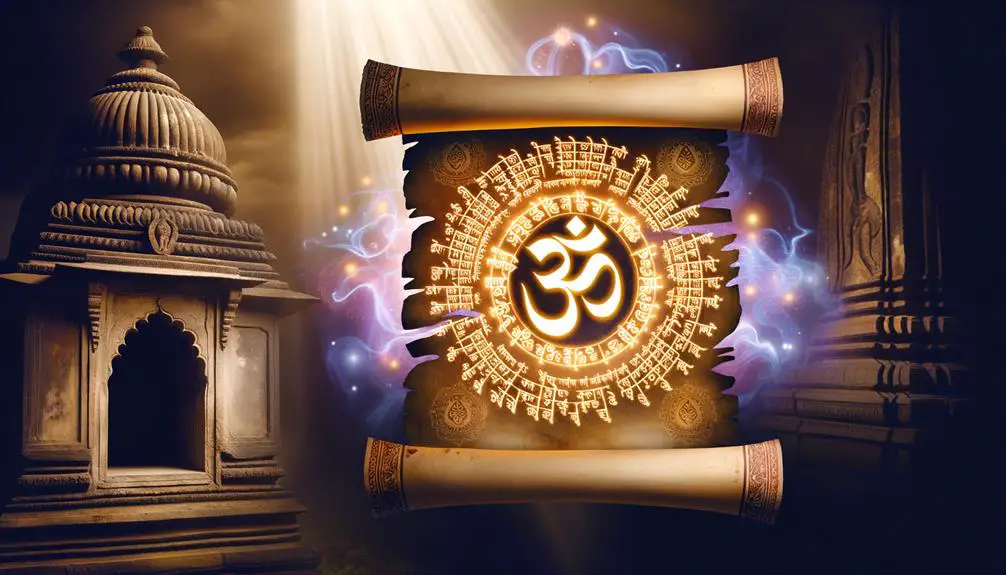
The historical origins of the Aum symbol can be traced back to the ancient scriptures of Hinduism, particularly the Vedas and Upanishads. These texts, some of the oldest known in human history, position Aum (or Om) as a foundational sound and spiritual icon.
The Mandukya Upanishad, for instance, offers a detailed exposition on Aum, describing it as a representation of the ultimate reality (Brahman) and the universe's essence. Vedic rituals often include the chanting of Aum, signifying its importance in spiritual practices.
This symbol's presence in such foundational texts underscores its integral role in Hindu cosmology and metaphysics. Additionally, Aum's adoption in various philosophical and meditative traditions further highlights its enduring significance across millennia.
Symbolic Elements

Aum's symbolic elements encompass profound philosophical concepts. Each aspect of the symbol represents different dimensions of existence and consciousness. The symbol is traditionally composed of three curves, a semicircle, and a dot.
The largest curve at the bottom signifies the waking state (Jagrat), where consciousness is outwardly directed. The middle curve represents the dream state (Swapna), a domain of inward consciousness. The upper curve denotes deep sleep (Sushupti), where consciousness is dormant.
The dot symbolizes the fourth state (Turiya), transcending common consciousness into pure, undifferentiated awareness. The semicircle beneath the dot signifies Maya, the illusion that veils the true nature of reality, preventing the lower states from realizing Turiya. Each element systematically encapsulates integral aspects of metaphysical thought.
Spiritual Significance
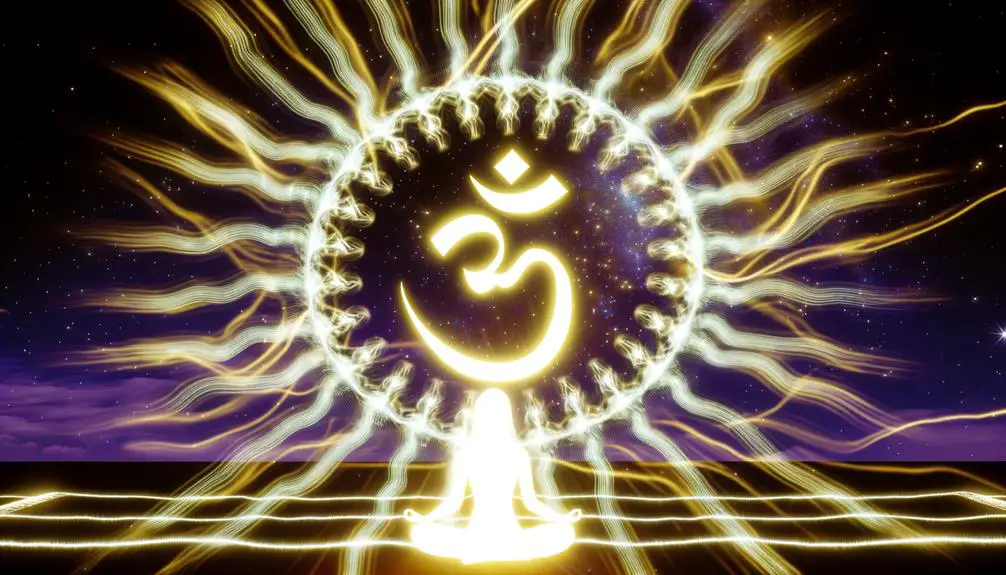
Interpreting the spiritual significance of the Aum symbol requires delving into its role as a sacred sound and its association with the ultimate reality in various philosophical traditions. Aum, often referred to as the primordial sound, symbolizes the essence of the universe and the interconnectedness of all existence.
In metaphysical terms, it represents the union of the physical and the spiritual, the manifest and the unmanifest. The chant of Aum is believed to harmonize the body, mind, and spirit, facilitating a deeper state of meditation and self-realization.
Aum in Hinduism

In Hinduism, the Aum symbol is revered as an ancient and sacred sound, believed to be the primordial vibration from which the universe originated.
Its profound spiritual significance is articulated in various Hindu scriptures, where Aum is described as embodying the essence of the ultimate reality, Brahman.
Additionally, the practice of chanting Aum during meditation is considered a powerful means to align one's consciousness with the spiritual truths it represents.
Sacred Sound Origins
Originating from ancient Vedic traditions, the sacred sound of Aum holds profound significance within Hinduism, serving as a fundamental spiritual symbol and a representation of the universe's underlying reality.
This primordial sound is documented in the Rigveda, one of the oldest known texts, where it is revered as the sonic essence of the cosmos. The syllable Aum is composed of three phonetic components: 'A', 'U', and 'M', each symbolizing different states of consciousness and existential planes.
Scholarly interpretations suggest that 'A' represents the waking state, 'U' the dream state, and 'M' the state of deep sleep. The convergence of these sounds embodies the totality of existence and reflects the all-encompassing nature of the universe as conceived in Vedic philosophy.
Spiritual Significance Explained
The profound spiritual significance of Aum in Hinduism extends beyond its phonetic components to encompass its role as a symbol of the ultimate reality and the interconnectedness of all existence. Aum represents Brahman, the supreme cosmic power, and is believed to encapsulate the essence of the universe. This sacred syllable is integral to Hindu metaphysics and theology for several reasons:
- Creation, Preservation, Destruction: Aum encapsulates the triadic nature of existence—creation (A), preservation (U), and destruction (M).
- States of Consciousness: It signifies the three states of human consciousness—waking, dreaming, and deep sleep.
- Path to Enlightenment: Aum serves as a spiritual tool for achieving moksha, the liberation from the cycle of birth and rebirth.
These aspects underscore Aum's pivotal role in Hindu spiritual practice.
Chanting and Meditation
Within the context of Hindu spiritual practices, chanting and meditating on Aum are considered essential techniques for deepening one's connection with the divine and achieving inner tranquility.
The Aum sound, composed of the syllables A-U-M, symbolizes the fundamental vibration of the universe, representing creation, preservation, and destruction. When chanted, it is believed to harmonize the individual's mind, body, and spirit.
Meditation on Aum, or 'Omkar,' focuses the practitioner's awareness on this primal sound, fostering a state of heightened consciousness. Scholars and practitioners assert that such practices aid in transcending the ego, promoting mental clarity, and facilitating a profound inner peace.
Therefore, Aum serves as both a spiritual conduit and a tool for meditative focus in Hinduism.
Aum in Buddhism
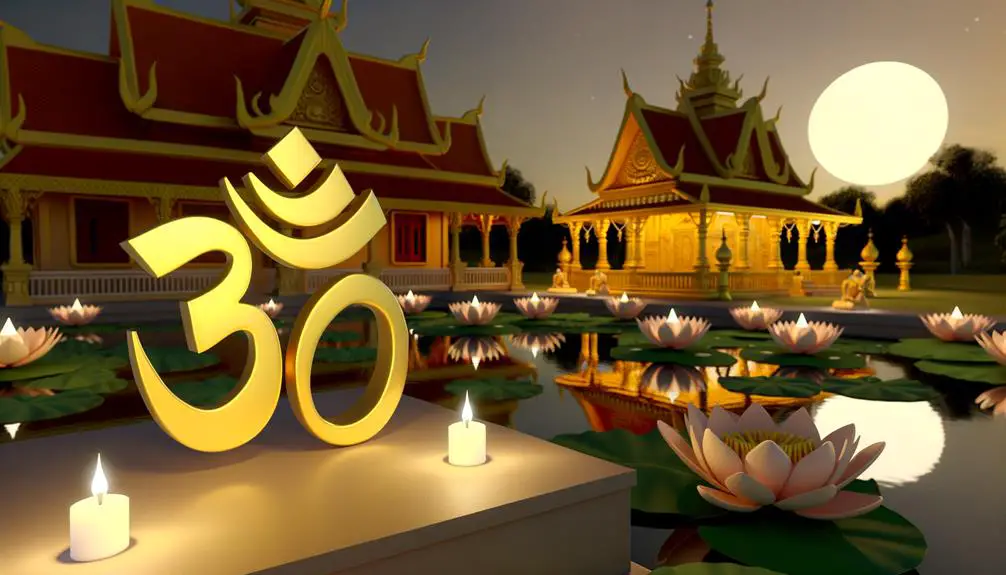
Aum holds a significant place in Buddhist practices and philosophy, symbolizing the unity and interconnectedness of all phenomena. Though primarily a Hindu symbol, Aum is integrated into Buddhist chants and mantras, serving as a tool for meditation and spiritual growth.
Specifically, Aum in Buddhism can be understood through its representation in the following aspects:
- Mantras and Chants: The use of Aum in mantras, such as 'Om Mani Padme Hum,' emphasizes compassion and the path to enlightenment.
- Meditation: Chanting Aum during meditation aids in focusing the mind and fostering inner peace.
- Doctrinal Symbolism: Aum encapsulates the essence of Buddhist teachings, reflecting the interconnectedness of all life and the impermanence of existence.
This integration highlights Buddhism's adaptability and syncretic nature.
Aum in Jainism
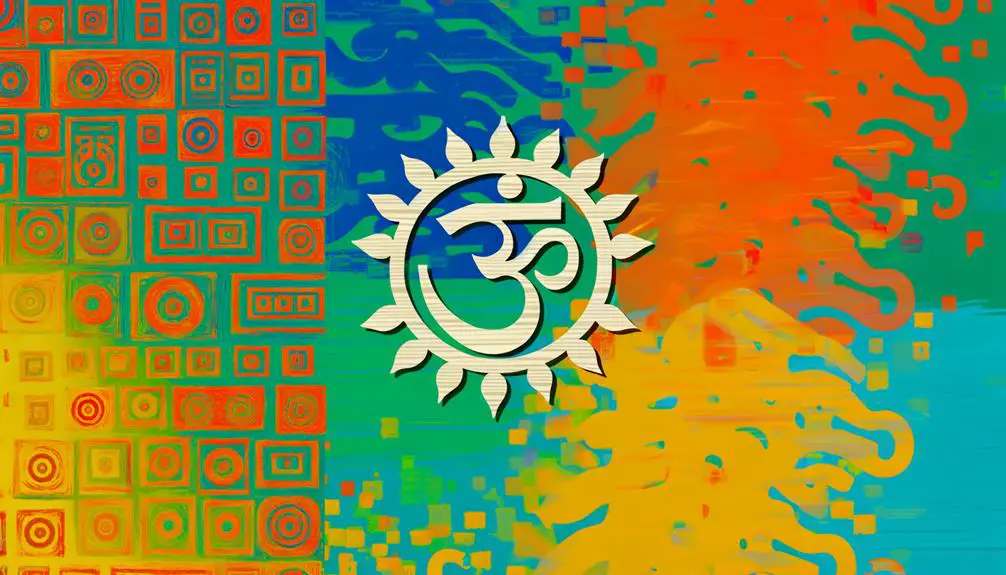
In Jainism, Aum represents the essence of the five supreme beings and serves as a powerful symbol for spiritual practice and reverence.
Specifically, the five supreme beings include Arihants (enlightened beings), Siddhas (liberated souls), Acharyas (spiritual leaders), Upadhyayas (teachers), and Sadhus (monks).
The syllable Aum is considered a condensed form of the initials of these beings, encapsulating their spiritual significance. It functions as a mantra during meditative practices, aiming to focus the mind and elevate spiritual awareness.
This symbol underscores the interconnectedness of all forms of spiritual guidance within Jainism and emphasizes the path to liberation through discipline and reverence for these supreme entities. Its usage in rituals and scriptures further solidifies its profound religious importance.
Modern Interpretations
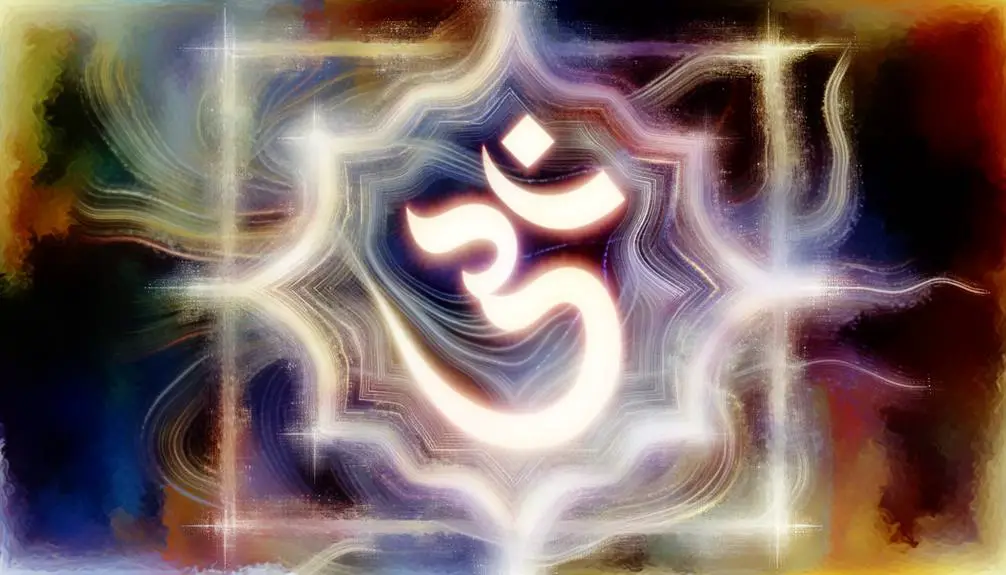
In contemporary contexts, the Aum symbol has transcended its traditional spiritual dimensions to encompass diverse modern interpretations. Its significance is evident not only in personal spiritual practices but also in its integration into various cultural adaptations and frequent representation in popular media.
This multifaceted evolution reflects the symbol's enduring relevance and adaptability within a globalized society.
Spiritual Significance Today
The contemporary interpretation of the Aum symbol often centers around its profound resonance with personal and collective spiritual awakening. This ancient symbol is increasingly recognized for its universal significance in today's diverse spiritual practices. Modern interpretations emphasize its role in fostering mindfulness, inner peace, and a deeper connection to the universe.
Key aspects of its contemporary spiritual significance include:
- Mindfulness and Meditation: Aum is frequently used in meditative practices to cultivate focus and tranquility.
- Unity and Universality: It symbolizes the interconnectedness of all existence, transcending cultural and religious boundaries.
- Vibrational Harmony: The sound of Aum is believed to align one's vibrations with the cosmic frequency, promoting holistic well-being.
These interpretations underscore Aum's enduring relevance in modern spiritual contexts.
Cultural Adaptations
Modern adaptations of the Aum symbol reflect its integration into various cultural contexts beyond its traditional Hindu and Buddhist origins. The symbol has transcended its religious connotations, finding new meanings within contemporary spiritual practices and secular settings.
In Western societies, Aum is often associated with yoga and meditation, serving as a universal emblem of peace and mindfulness. Additionally, it appears in modern art, fashion, and personal adornment, symbolizing a broader quest for inner harmony and balance. This cross-cultural adoption underscores the symbol's versatility and enduring relevance.
However, such adaptations raise questions regarding cultural appropriation and the preservation of the symbol's authentic spiritual significance, warranting further scholarly examination and dialogue.
Popular Media Usage
As the Aum symbol permeates various cultural contexts, its representation within popular media further exemplifies its evolving interpretations and widespread appeal. This symbol, originally rooted in spiritual and meditative traditions, now transcends its historical confines to find expression in modern entertainment and digital platforms.
Several key manifestations of the Aum symbol in popular media include:
- Film and Television: Frequently incorporated into storylines or visuals to evoke themes of spirituality and inner peace.
- Music and Art: Artists and musicians often adopt the symbol to represent universal harmony and transcendence.
- Fashion and Merchandise: The symbol is commonly used in apparel and accessories, signifying a blend of cultural reverence and contemporary aesthetics.
This multifaceted presence underscores the symbol's adaptability and enduring relevance.
Conclusion
The Aum symbol, a profound emblem rooted in ancient traditions, encapsulates the essence of universal existence. Through its historical origins and diverse spiritual significance in Hinduism, Buddhism, and Jainism, Aum represents the cyclical nature of life and consciousness.
Its modern interpretations continue to resonate, bridging the ancient with the contemporary. Consequently, Aum serves as a timeless key, revealing the mysteries of the cosmos and the depths of human spirituality, symbolizing an eternal quest for understanding.





